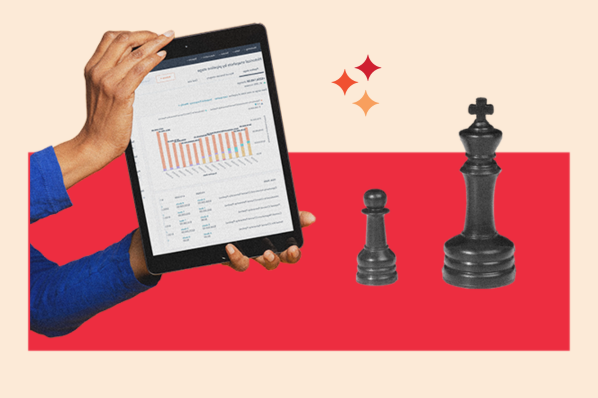So, what's the plan? Or should I say, what's the strategic plan?
Without a proper strategy, your business or organization can suffer. But, with strategic planning, businesses can increase productivity, profitability, and increase their longevity by creating a clear plan for the future.
Download Now: Free Growth Strategy Template
Does strategic planning sound too good to be true?
While it sounds great in theory, it can be challenging in practice. In fact, 56% of executives and their teams wasted time on strategic planning, while only 44% spent the strategic planning time productively.
Luckily, you can join the 44% of leaders and teams that had productive strategic planning sessions. If you take the right approach, strategic planning can positively impact your business and its bottom line, and it will certainly be worth your time.
What is strategic planning?
Strategic planning is a process conducted by a business's leadership to set long-term goals and priorities for the business, outline ways to reach these goals, and dictate how progress will be measured. The overall goal of strategic planning is to provide a clear action plan.
Common frameworks for strategic planning include the Balanced Scorecard (BSC), Objectives and Key Results (OKR), and the Theory of Change (TOC).
Balanced Scorecard Institute sums up strategic planning nicely:
"It is a disciplined effort that produces fundamental decisions and actions that shape and guide what an organization is, who it serves, what it does, and why it does it, with a focus on the future. Effective strategic planning articulates not only where an organization is going and the actions needed to make progress, but also how it will know if it is successful."
What is the purpose of strategic planning?
The purpose of strategic planning is for an organization to determine the direction it will head in over the next three to five years. You’ll set overarching goals, outline how you want to achieve them. Strategic plans are often adjusted based on market changes or unforeseen threats, so they may be modified to respond to changes in the business environment (internal or external).
When speaking of the importance of strategic planning, the Small Business Administration says that strategic planning is essential “Only if you want to stay in business and prosper.”
When you have long-term business goals, it becomes easier for different departments in your organization to plan their activities, allocate resources, and take actions that will help your business meet your goals in the designated time frame. The plans created from strategic planning are called operational plans, and we’ll discuss the difference between the two concepts below.
Strategic vs. Operational Planning
An organization uses strategic planning to outline its long-term visions and goals for the next three to five years. These are the overarching priorities for the entire company. Operational planning supports the strategic plan. Different departments and divisions of the organization focus on short-term goals that can be accomplished within a year and impact the priorities set in the strategic plan.
Strategic plans contain your goals for the future, and operational plans share the daily, monthly, quarterly, etc., actions that will help your business achieve those future goals. Operational plans help you put your strategic plans into action.
Operational planning is often performed by individual departments or team leaders. They focus their efforts on creating strategies and tactics they can pursue throughout the year to support the broader goals in the strategic plan.
Let’s say your business executives create a strategic plan to increase revenue by 75% in three years.
It’s an ambitious goal, so you want your business to take structured actions to bring your business down the path of achieving that goal. Each department will be responsible for creating operational plans that will increase revenue by 75% in three years.
Customer service may focus on customer retention, so customers are more likely to stay on and continue paying for your benefit, sales teams may focus on upselling existing customers and filling pipelines with qualified leads, and marketing teams may work on creating better buyer personas to ensure they’re always reaching the right customers. Each department's operational plan will contribute to increasing revenue to the desired amount.
Strategic Planning and Sales Teams
While the example above incorporates sales into the strategic planning process, let’s go a bit more in-depth.
The strategic plan is determined by senior leadership or executives to develop a long-term vision for the company. Then, it’s up to individual departments to create plans and strategies for their teams to align with and work towards the objectives set in the strategic plan.
Sales leaders create a sales plan (operational plan) that outlines the short-term strategies and tactics used to achieve long-term goals. This aligns sales teams and salespeople, so they know exactly what they're working towards and how progress and success will be measured.
Now that we know why strategic planning is important let's go over the strategic planning process.
Strategic Planning Process
The strategic planning process is when company leaders hold planning sessions to define the business’ overall vision and high-level, long-term goals that the business wants to achieve. The outcome of a strategic planning process is a strategic plan.
What is a strategic plan?
A strategic plan is a written document that contains the long-term goals the business wants to meet, and the resources and tactics that will be used to reach them. The length of a strategic plan varies depending on the complexity of the company and its size, but the document is a source of truth that keeps the organization on track to meet its goals.
So, what exactly does the strategic planning process look like? Here are the steps.
Strategic Planning Process Steps
- Prepare for strategic planning.
- Assess the business.
- Outline your mission, vision, and key stakeholders.
- Choose a strategic planning framework.
- Create a strategic plan.
1. Prepare for strategic planning.
Who do you want to include in the strategic planning process? Ideally, you should assemble a cross-functional group that includes executives and leadership from your critical business functions (e.g., finance, operations, product, sales, marketing, human resources, etc.).
After your strategic planning group is assembled, set a timeline for completion. Depending on the size or complexity of your company, planning can take anywhere from a few weeks to a few months. Pick a timeline that works best for your organization.
2. Assess the business.
Look at the internal and external factors that impact your business. For example:
- Is there a particular business area that's growing quickly? How can the business further support its growth?
- Will a new technological advancement help improve your business processes?
- Are any pieces of legislation being passed that the company needs to respond to?
These are just a few things to consider when evaluating the environment your business is operating in. Tools like SWOT Analysis, Porter's Five Forces, and PESTLE Analysis can help you assess the strongest and weakest parts of the organization. Plus, you can determine opportunities for growth and see where potential challenges might arise.
3. Outline your mission, vision, and key stakeholders.
What’s your business’ mission or vision? Identify the core values and priorities of your business by outlining your mission and vision statements.
It’s also important to identify your target customers as well. You’ll want to create accurate customer profiles so you know their pain points and exactly how you fit into the picture when it comes to solving them. While your customers are your primary stakeholders, you also want to identify all other stakeholders (e.g., employees, owners, board members, suppliers) so you understand exactly who your strategy will impact.
When working through the strategic planning process, you'll start by outlining your aspirational goals first, so you can eventually develop specific strategies and tactics that will be used to achieve the aspirational goals.
4. Choose a strategic planning framework.
There are a variety of different strategic planning models that will help you develop your plan, and here are the most common frameworks used for strategic planning:
- The Balanced Scorecard (BSC): This framework helps you outline your business’ mission, vision, and strategy in a visual map that your business can follow. It includes strategic objectives, targets, measures and KPIs, and the strategic initiatives that will help you reach your goals.
- Objectives and Key Results (OKR): This framework involves making a list of three to five high-level objectives. Below each objective, you’ll list three to five quantifiable key results that will be measured with a score between 0 to 1 or 0-100%. Check out these OKR examples to get started.
- Theory of Change (TOC): This framework helps you identify your long-term goals, then work backward to determine what needs to happen in order to reach each goal. Here is an in-depth description ofhow and when to use the Theory of Change method.
By using these frameworks, you'll be able to develop your strategies, the tactics you'll use to accomplish them, and the key performance indicators (KPIs) you'll use to track performance.
5. Create a strategic plan.
Now that you've consulted with your team and came up with your long-term plans, it's time to record the agreements and strategies in a strategic plan. The strategic plan is a physical document that can be shared across departments in the company.
But, many companies have gone digital with strategic planning software, so their strategic plan can be accessed by anyone in the company from their electronic devices. Many of these software options are collaborative for people at all levels of the company, which increases the transparency of the business' primary goals.
Strategic Planning Software
Need some tools to start your strategic planning with? Here are some strategic planning software options, in no particular order.
1. Cascade Strategy
Cascade Strategy helps you create a plan and execute it with its strategy planning platform. It allows you to create a strategy map, outline your goals, and include specific details like goal timeframes and the metrics used to evaluate goal achievement.
Additional features include a KPI builder, smart frameworks, goal and project management tools, and dashboards to report on progress.
What we like:
Cascade’s strategy planner helps you define your long-term goals, and an easy-to-use drag and drop builder allows you seamlessly input the operational plans that will help you achieve those goals.
2. ClearPoint Strategy
This strategic planning tool has Balanced Scorecard Software that enables you to build your strategic plan. The platform provides you with the ability to build interactive Balanced Scorecards, and create dashboards and strategy maps to track your goals.
You can assign elements of the strategic plan to different owners so they can tackle specific parts of the strategy.
What we like:
Allows you to visualize your strategic plans and operational plans all in one place, making it easy to understand goal attainment and areas that need strategy upgrades.
3. WorkBoard
WorkBoard offers a strategic planning solution that's specifically for CEOs and General Managers. And with tools like the active OKR solution, teams can identify plan using the Objectives and Key Results (OKR) technique.
The tool provides a way to align organizations and help them identify risks with OKR heatmaps.
What we like:
WorkBoard objective and key results tool helps you visualize goal alignment across your organization to increase transparency and help you understand progress towards meeting your strategic plan goals.
4. Khorus
Khorus is a strategy execution software that creates transparency for CEOs, management, and individual contributors. CEOs set objectives in Khorus, and then teams and individuals can add their own goals that contribute to the overarching objectives.
This strategic planning software improves the ability of businesses to execute their strategies, and it increases alignment and transparency.
What we like:
Built for executive leadership that puts together the strategic planning and is compatible with any goal methodology that works best for your business (SMART goals, OKR, MBO).
5. COMPASS® Quality Management System
With this project portfolio management system, you can manage ideas and projects to help you and your team develop a strategy. An interesting feature is the star rating system that allows employees to rate each project. The system takes this information, analyzes it, and rates the project's overall potential.
The tool creates transparency between leaders and employees, and management is able to engage with the feedback to improve upon their strategic goals and projects.
With a strategic plan, your company and your sales organization will be well-equipped to set goals and achieve them.
.png?width=112&height=112&name=Image%20Hackathon%20%E2%80%93%20Vertical%20(56).png)
















